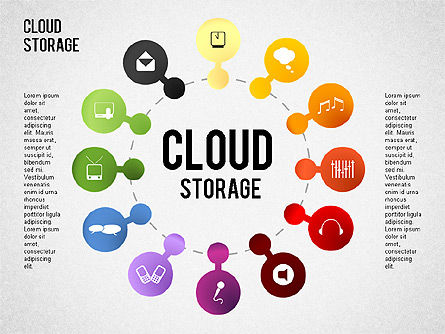Cloud storage is a service model in which data is maintained, managed, backed up remotely and made available to users over a network (typically the Internet). Users generally pay for their cloud data storage on a per-consumption, monthly rate. Although the per-gigabyte cost has been radically driven down, cloud storage providers have added operating expenses that can make the technology more expensive than users bargained for. Cloud security continues to be a concern among users. Providers have tried to deal with those fears by building security capabilities, such as encryption and authentication, into their services.

The cloud-based storage market is dominated by Amazon Web Services, Google and Microsoft Azure,but traditional storage vendors like Emc,Helwett Packard Enterprise,Hitachi Data System,IBM and Netapp also operate in the space with products for both enterprise and small business owners that include self-service portals to provision and monitor use.

There are three main cloud-based storage architecture models: public, private and hybrid.
Public cloud storage services provide a multi-tenant storage environment that is most suited for unstructured data. Data is stored in global data centers with storage data spread across multiple regions or continents. Customers generally pay on a per-use basis similar to the utility payment model. This market sector is dominated by Amazon Simple Storage Service (S3), Amazon Glacier for cold storage, Google Cloud Storage, Google Cloud Storage Nearline for cold data and Microsoft Azure.
Private cloud, or on-premises, storage services provide a dedicated environment protected behind an organization's firewall. Private clouds are appropriate for users who need customization and more control over their data.
Hybrid cloud is a mix of private cloud and third-party public cloud services with orchestration between the platforms for management. The model offers businesses flexibility and more data deployment options. An organization might, for example, store actively used and structured data in an on-premises cloud, and unstructured and archival data in a public cloud. In recent years, a greater number of customers have adopted the hybrid cloud model. Despite its benefits, a hybrid cloud presents technical, business and management challenges. For example, private workloads must access and interact with public cloud storage providers, so compatibility and solid network connectivity are very important factors. An enterprise-level cloud storage system should be scalable to suit current needs, accessible from anywhere and application-agnostic.
Cloud storage is based on a virtualized infrastructure with accessible interfaces, near-instant elasticity and scalability, multi-tenancy and metered resources. Cloud-based data is stored in logical pools across disparate, commodity servers located on premises or in a data center managed by a third-party cloud provider. Using the RESTful API, an object storage protocol stores a file and its associated metadata as a single object and assigns it an ID number. When content needs to be retrieved, the user presents the ID to the system and the content is assembled with all its metadata, authentication and security.
In recent years, object storage vendors have added file system functions and capabilities to their object storage software and hardware largely because object storage was not being adopted fast enough. All backup applications use the object storage protocol, which is one of the reasons customers first tried backing up their data to the cloud.
Common cloud storage use cases
The most common use cases are cloud backup,disaster recovery and archiving infrequently accessed data.A greater number of customers also use cloud storage services for DevOps as a capital cost-cutting measure.They can just spin up the compute and storage resources for the duration of the project and then spin them down when it ends.
Market leadersCommon cloud storage use cases
The most common use cases are cloud backup,disaster recovery and archiving infrequently accessed data.A greater number of customers also use cloud storage services for DevOps as a capital cost-cutting measure.They can just spin up the compute and storage resources for the duration of the project and then spin them down when it ends.
The cloud-based storage market is dominated by Amazon Web Services, Google and Microsoft Azure,but traditional storage vendors like Emc,Helwett Packard Enterprise,Hitachi Data System,IBM and Netapp also operate in the space with products for both enterprise and small business owners that include self-service portals to provision and monitor use.
0 comments:
Post a Comment